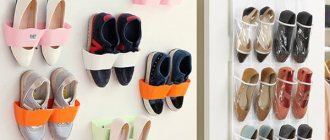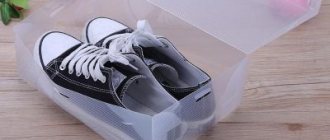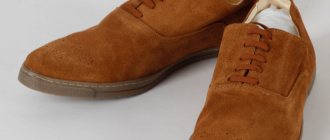Shoe preparation and storage rules
In some cases, the issue of shoe distribution concerns seasonal products that will not be needed for at least a month or two. And if summer slates and sandals are easier to hide, due to their relative compactness, then winter boots will require much more space and better organization of space.
Before putting away your shoes, it is important to properly prepare them for seasonal storage so that they last for many years and maintain their appearance:
- Only clean shoes can be stored. Before placing a pair of shoes or boots in a “long box”, it is worth washing the soles from dust and dirt, walking over the surface with a cloth or sponge, then wiping them dry. Dirty shoes are not stored because it is unhygienic, inconvenient and destructive to the surface (dirt and sand may contain reagents used to treat roads).
- To prevent creases, abrasions and deformation, boots should be tightly stuffed with paper, cloth or polyethylene. Plastic or foam molds and pads are also suitable.
- Pairs made from natural materials must be treated with special care compounds to prevent cracking.
- If the shoes have been damaged, it is better to have them restored or sent to a workshop before sending them for seasonal storage. It is advisable to throw out worn-out shoes and boots altogether - why keep unnecessary and long-outdated items at home?!
- Divide pairs by season, accessories (men's, children's, women's), frequency of use.
Insects
The ubiquitous moth butterflies are a classic of the genre. Do you think moths will disdain shoes? You are wrong! This clothing locust is extremely democratic when choosing “dishes”. Natural fur on shoes, if there are also traces of sweat on it, is a wonderful delicacy. Also, a small detail: shoe boxes always (should have!) holes for ventilation. And if you leave fur shoes without proper attention, moths, alas, will definitely get there. The times of total shortages are long behind us, but in order to avoid not very pleasant incidents, we recommend treating shoes with fur trim with a special compound or anti-moth spray. Additionally, tablets, briquettes, plates, cedar balls or sachets and other repellents can be placed in shoe boxes or plastic containers.
To summarize, we can note the simplicity and accessibility of the rules considered: compliance with them does not require any difficulty or serious material costs for owners, and the result will be favorite shoes that can last for a long, long time.
Storage in original boxes
The most obvious option is to put the shoes in the cardboard boxes in which they were brought from the store. By the way, many people do this, and as a result, you inadvertently find a bunch of boxes of different colors in the closet, dressing room or on the mezzanine. This method has a right to exist; storing winter shoes often works out this way.
Advantages:
- store boxes - a ready-made storage option suitable for the size of a specific pair;
- protection from dust, moisture, external environmental factors;
- free – no need to spend money on cases and organizers;
- relatively compact.
About the disadvantages:
- visual noise. Boxes of different colors, shapes and sizes create a feeling of disorder and attract unnecessary attention. On open shelves and racks, piles of boxes look sloppy; the best option is to organize storage in a closet;
- different sizes and dimensions create difficulties with placement. You will have to play with spatial thinking in order to store all the boxes in one area as compactly as possible.
Selection of storage accessories
As a useful accessory, a stand for shoes and boots is used, which is designed for two pairs at once. This method of storing shoes allows you to save useful space inside the closet or on the shelves.
The photo shows a plastic stand for storing two pairs of shoes.
In order to store shoes without boxes, you can purchase or sew bags made of thick but breathable fabric yourself.
Instead of using bulky boxes and containers, a pair of shoes is simply held together with an elastic band and packaged in airtight organizers that can be hidden under the bed or placed on the loggia.
The photo shows storing shoes in multi-colored sealed bags.
Organizers, storage systems
There are a lot of goods and useful little things for the home on sale; you can buy them in almost any supermarket. Cute similar organizers for storing pairs of shoes are a godsend for perfectionists. Open boxes, fabric folding cases, mesh organizers with locks in the same style - convenience and beauty in “one bottle”.
Their advantages:
- visual harmony, sense of order;
- ease of storage;
- speed of identification (such organizers have special transparent windows or labels for marking).
Flaws:
- additional expenses;
- small sizes. Typically, summer or small-sized shoes are stored in organizers. But it’s already difficult to place high boots there.
Advice! If you don’t want to spend money on beautiful rag or cardboard organizers, you can use a worthy alternative - transparent plastic open or closed containers. The only caveat is to ensure proper ventilation by making holes for air exchange inside the container.
Wall structures
A non-standard solution - wall structures made of metal rods. The heel is hooked onto them and the shoes are stored in this way. Such structures can be placed anywhere - in a wall niche, in the spaces between furniture, on the inside of the closet door.
You can simply hang all your shoes in pockets-bags on the wall, and so that they do not confuse the eye, decorate them with a curtain or a sliding curtain.
How to store shoes without boxes?
It happens that the packaging is lost, thrown away, deformed or missing altogether (usually shoes in non-specialized chain stores are sold without boxes). In such a case, there are several options for placing unused pairs.
Shelves in the closet
The storage system helps to rationally use wardrobe space. Shoes in the closet can be stored in special shoe compartments and on shelves, as well as in metal mesh baskets - you just have to decide what is best for a particular case.
Shoe shelves located in the closet are:
- stationary - ordinary products made from furniture panels, on which it is convenient to place various objects, incl. shoes;
- retractable - shelves with movable fittings, allowing you to easily reach hard-to-reach places and get what you need from the depths of the cabinet. Save space and easy to use;
- folding - these can often be found in shoe racks or special compartments for shoes in a prefabricated storage system. They run smoothly and are very comfortable.
Railings and slats in the closet
An interesting and quite popular way to store things and shoes is a railing system and slats. This solution saves space inside, while allowing you to place a fairly large volume of cabinet contents. Typically, roof rails are installed in compartments for outerwear and things on hangers, but shoes can also be stored on tubes by hanging them on special hangers or placing them on two adjacent tubes.
Shelves in the dressing room
If the space allows you to have your own dressing room, and there are a lot of shoes, then beautifully arranging shoes on shelves in a magazine style is one of the right solutions to the storage issue.
This room can have both open and closed shelving, but open shelving is best for storing shoes or footwear in good condition. In closed ones you can hide everything that is not so attractive to the eye, but provided that the doors are not made of transparent glass.
On hangers
An interesting option for storing high boots and shoes with elastic tops is to hang them on hangers with rubberized clips. This fastening does not deform the shoe material, the boots can be placed compactly, and the method itself is quite extraordinary.
On special spacers
Such devices can be purchased as an option when purchasing a wardrobe system or sold separately. The idea is to put each pair on special spacers, which can be retractable or static. Shoes are convenient to take off and put back in place; they do not deform during storage and are less prone to creases.
Advice! You can make a rack with spacers for boots yourself at home, using improvised means or ordinary PVC pipes with fasteners.
In the shoe store
A good option for storing frequently used pairs of shoes is a special cabinet - a shoe rack. The drawers and doors are designed in such a way that when opened, shelves with shoes slide out. Such furniture allows you to conveniently arrange all pairs, easily find them and remove them if necessary.
Shoe racks, due to their depth and width, take up little space, which allows them to be placed even in a small hallway.
Advice! Shoe racks with mirrored doors will allow you to neatly place all your seasonal shoes in the hallway and save on the purchase of a mirror.
Original homemade devices
An old stepladder or ladder will serve as a shoe rack. The structure is decorated and fixed to make it more stable. Shoes and boots can be stored on the steps, and the rungs can be supplemented with hooks for hats and other accessories.
The remains of PVC water pipes represent a budget-friendly, but at the same time original shoe storage. The independent process of creating such a system does not take much time.
For indoor slippers or ballet shoes, it is appropriate to mount several aluminum jars on the wall. Such products have a neat, stylish and less bulky appearance, unlike plastic pipes. This design will fit perfectly into a small corridor in an industrial loft style.
The photo shows the idea of storing shoes in plastic pipes.
A simple metal lattice on which you can store shoes by hanging them by the heel will look impressive in the interior. In order to construct a shelf, scraps of pipes or an old battery are suitable.
Designs in the form of a shoe rack made from ordinary boxes, wire baskets, wooden packing boxes or a compact cardboard rack will help you organize storage correctly.
Sneakers and sneakers can be stored on shelves made of skateboards, and a memorable pair of shoes, such as a wedding, can be covered with an elegant glass cover and made the central decoration of the dressing room.
How to store shoes if there is little space?
A small living space requires proper organization of storage and maximum use of scarce square meters. It is quite difficult to arrange all the things in a limited area, so non-standard solutions are used.
Under the bed
Usually the under-bed space is not used at all, the maximum is drawers for linen. But if there is catastrophically little space, any solutions are useful:
- for example, for a small apartment, fairly high beds with a lifting mechanism are purchased, inside of which you can store seasonal items and boxes of small items;
- An alternative option is to store out-of-season shoes under a regular bed with legs in cardboard boxes, drawers, organizers, and plastic containers. In this case, getting to the desired pair will be more difficult than with a lifting mechanism or roll-out boxes. But the boxes that spoil the appearance are safely hidden from view.
Under the stairs
If you are the owner of a home with several floors, then to save space you can adapt the openings under the stairs for storage systems. You can equip the space with shelves, racks, or simply stack boxes on top of each other. The main thing is that everything fits.
In the back room
Utility rooms and storage rooms often become places where seasonal and unused items accumulate. It is logical to organize shoe storage in the utility room, but first you should carry out an audit and get rid of unnecessary things. Placement options: boxes, drawers, organizers, baskets, shelves and even a railing system.
On hanging shelves
Often, in order not to clutter up the already scarce space with furniture, hanging wall shelves are used to organize storage areas. Often this solution is found in narrow corridors and small hallways.
With this method, it is recommended to additionally pack shoes to protect them from moisture, dust and sunlight. You can store pairs nicely and compactly in identical cases or boxes, and shoes without packaging should be stored in dust bags.
Baskets and buckets
For a hallway or dressing room in Provence or classic style, shoes can be stored in eco-friendly wicker baskets. Similar products, distinguished by high decorative properties, are placed under a bench or placed on shelves.
The photo shows wicker shoe baskets located under the bench in the hallway interior.
An interesting idea for storing shoes would be to use bright buckets. In these containers, intended for completely different purposes, you can store compact shoes.
Is it possible to store shoes on the balcony?
This question comes up quite often, since in small Russian apartments the balcony is one of the most popular places for storing seasonal items.
Yes, this option for placing winter shoes in the summer is possible subject to certain conditions:
- the balcony is glazed and insulated - this minimizes the likelihood of damage to things by dampness, dust and sunlight;
- shoes are stored in closed but ventilated containers or canvas bags, away from sunlight;
- pairs are prepared for the off-season and are filled with material inside to avoid deformation.
It is strictly not recommended to store any shoes on the balcony in winter - the products will inevitably be destroyed by temperature changes, excess humidity, and freezing of residual moisture in the pores of the material.
The exception is insulated heated balconies, where the temperature regime is +15 to +25°C.
Where to store?
For everyday storage, it is best to allocate a room specially equipped for this - a dressing room with a good ventilation system and shelving. If the area of the apartment does not allow for such luxury, then you can use wardrobes, shoe boxes, and hanging shelves.
To store seasonal shoes, boxes, special containers, organizers, fabric covers, and the like are most often used. The main conditions that must be observed when choosing them:
- presence of holes for ventilation;
- sufficient volume;
- no foreign odor.
Storing shoes made from various materials
It is important to understand that the durability of shoes largely depends on both its quality and proper use and further storage. Different materials require special treatment and care, so long-term storage conditions may vary.
Leather
Leather shoes are beautiful, comfortable and durable, but they are finicky and require special care and must be moisturized to prevent them from drying out and cracking. Before storing shoes made of genuine leather:
- Wash your boots from street dirt and dust and dry them.
- Use filler or shoe lasts to prevent deformation. It is better to hang boots with high tops, but do not fold the top in half.
- Treat the surface with moisturizers or shoe cosmetics to prevent drying and add shine. You can simply lubricate the skin with vegetable oil applied to a cotton pad.
Suede, velor, nubuck
Shoes made of velvety material require delicate care and careful wear. The same rules apply to storage:
- It is better not to wash dirty suede boots, but to wait until the dirt has dried and carefully brush off the residue with a special brush, and only then wipe it with a damp cloth;
- the entire outer surface is treated with a special dirt- and water-repellent impregnation; Shoes are placed in pairs in storage areas.
Advice : do not use leather shoe creams on velor, nubuck and suede; there are specialized cosmetics for these materials!
Textile
Fabric shoes and boots can be machine washed on a special cycle. The main thing is to avoid stains, which often remain on light-colored fabric. Usually an additional spin and rinse is performed, then the vapors are thoroughly dried and stored in a dark, dry place.
Rubber
Rubber boots and galoshes are considered easy to care for, but under unsuitable conditions even such shoes can become unusable:
- do not store rubber boots in sheds and basements where rodents may be present;
- Dampness and moisture negatively affect rubber, as a result of which it loses its former elasticity and becomes “tanned.”
Patent leather shoes
Most will agree that one of the most finicky coatings is varnish. It quickly loses its shine and cracks under unsuitable conditions and improper care. Patent leather shoes are usually worn on special occasions, so they are often stored on closet shelves or in a box. To prevent patent leather shoes from losing their shine, before putting them away:
- treated with special moisturizing cosmetics;
- installed inside the pad or filled with paper;
- put in dust bags to prevent scratches;
- sent in a box to a dry place without access to sunlight.
Advice! Nail polish of a similar color will help hide scratches on patent leather shoes.
Sneakers
Sports shoes are usually made from different materials:
- natural or artificial leather,
- textiles,
- polymer materials,
- suede, etc.
Most often, sneakers are intended for washing, but if nubuck or suede was used in their manufacture, it is better not to do this.
The soles of sneakers get dirty the most when walking. This is especially noticeable if she is white. You can return it to its original appearance using soap and an old toothbrush. Active cleaning with detergent or tooth powder can completely remove dirt from the soles.
Machine washing of sneakers is contraindicated. Excessive exposure to such shoes can result in damage. But insoles and laces are not afraid of such washing. By the way, they should be replaced with new ones at least once a season.
After hand washing and cleaning the soles, the sneakers should be thoroughly dried. But you should not leave them in the sun, or use a radiator, a hot hair dryer or other heat sources.
It is advisable to store sports shoes in their “original” box, in a closet or on the mezzanine.
DIY shoe rack
To conveniently store all your shoe wealth, you won’t need to spend a lot of money, because you can make a convenient rack with your own hands from available materials.
To make a bookcase, take:
- 6 thin planks measuring 1 m x 30 cm;
- thin planks 4 pcs. size 1 m 20 cm x 30 cm;
- roulette;
- pencil;
- saw.
The simplicity of this product lies in the fact that you do not need screws or nails to make it. At any time, you can disassemble this interesting shelf to temporarily remove it or move it to any other place. An organizer for storing shoes is created according to the following scheme:
- Take short boards and measure the middle of the width of each with a tape measure. That is, 30/2 = 15 cm. Draw a midline. Divide the length of the board into 4 parts (1 m / 4 = 25 cm), and on one side make cuts along the marking to the previously drawn midline. You will get horizontal crossbars.
- To design the vertical sides, take 4 longer boards, in the same way find the middle line of each (30 cm/2 = 15 cm), marking it with a pencil, and make 6 cuts to it with equal distances between them. Horizontal shelves will be installed there.
- Assemble the structure by inserting the parts along the cuts into the lock.
Hanging model on the pantry wall
It's quite easy to make a hanging shoe organizer with a double wall that resembles a wall mat with pockets. For this, it is important to select a dense fabric and one that can stretch. With standard door dimensions of 200 cm x 70 cm you will need:
- a piece of thick fabric (like canvas) measuring 100 cm x 50 cm;
- a piece of knitted elastic measuring 100 cm x 50 cm;
- scissors, thread;
- sewing machine (with it, sewing will be better and more convenient);
- chalk for marking.
Important! The size of the fabric directly depends on what size organizer you will sew.
The manufacturing process is quite simple:
- Sew the edges of a piece of canvas to prevent it from fraying later.
- Cut pockets of the size you need from the elastic band (so that your shoes will fit into it later).
- Place the pockets on the canvas the way you want. It is not necessary to adhere to strict geometry.
- Sew 3 sides of the pocket, leaving one untouched.
- Decorate the product with any appliques or braid.
Important! Before placing shoes in the pockets, they must be washed and dried, otherwise you will stain the product.
As you may have noticed, storing shoes can be not only easy, but also beautiful. What ideas are close to you? Describe your experience in the comments.










